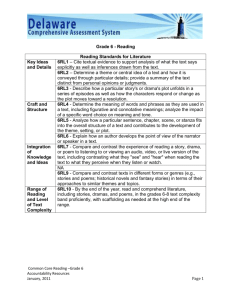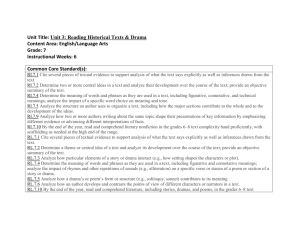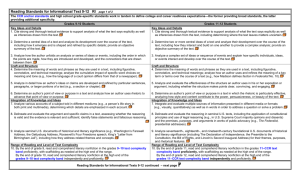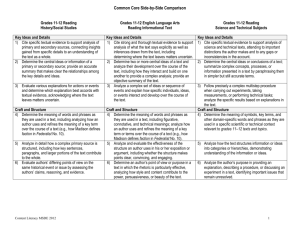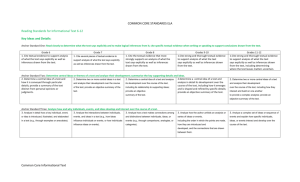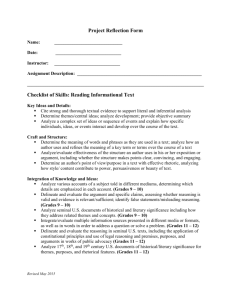NCSIP Reading Foundations Crosswalk
advertisement
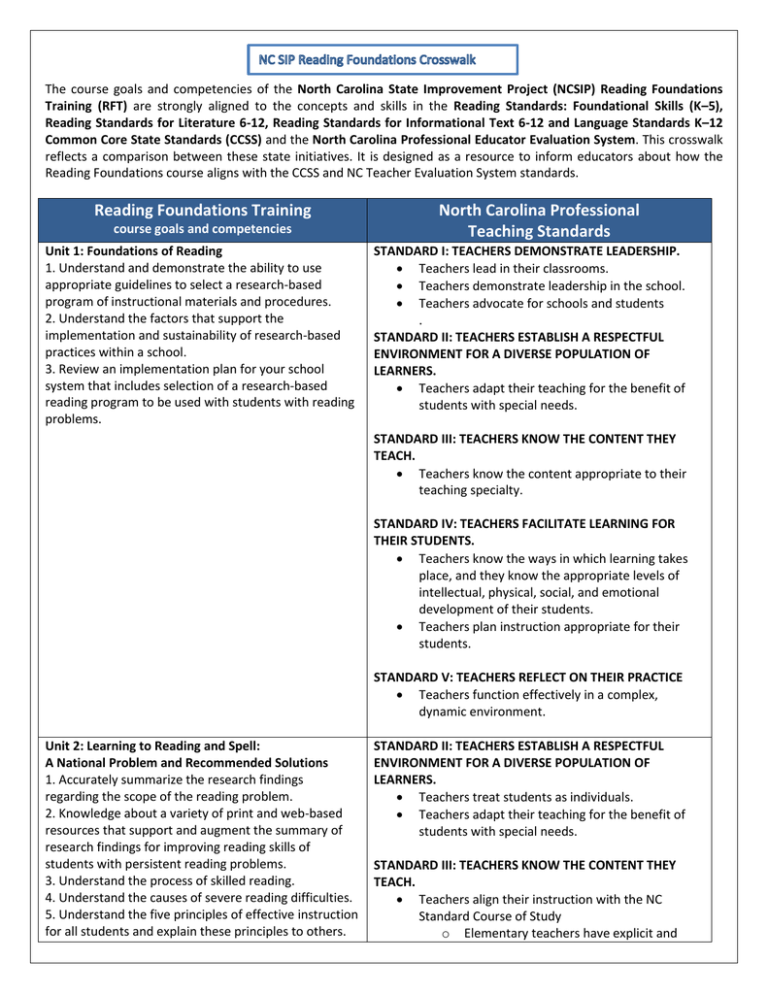
NCSIP Reading Foundations Crosswalk The course goals and competencies of the North Carolina State Improvement Project (NCSIP) Reading Foundations Training (RFT) are strongly aligned to the concepts and skills in the Reading Standards: Foundational Skills (K–5), Reading Standards for Literature 6-12, Reading Standards for Informational Text 6-12 and Language Standards K–12 Common Core State Standards (CCSS) and the North Carolina Professional Educator Evaluation System. This crosswalk reflects a comparison between these state initiatives. It is designed as a resource to inform educators about how the Reading Foundations course aligns with the CCSS and NC Teacher Evaluation System standards. Reading Foundations Training course goals and competencies Unit 1: Foundations of Reading 1. Understand and demonstrate the ability to use appropriate guidelines to select a research-based program of instructional materials and procedures. 2. Understand the factors that support the implementation and sustainability of research-based practices within a school. 3. Review an implementation plan for your school system that includes selection of a research-based reading program to be used with students with reading problems. North Carolina Professional Teaching Standards STANDARD I: TEACHERS DEMONSTRATE LEADERSHIP. Teachers lead in their classrooms. Teachers demonstrate leadership in the school. Teachers advocate for schools and students . STANDARD II: TEACHERS ESTABLISH A RESPECTFUL ENVIRONMENT FOR A DIVERSE POPULATION OF LEARNERS. Teachers adapt their teaching for the benefit of students with special needs. STANDARD III: TEACHERS KNOW THE CONTENT THEY TEACH. Teachers know the content appropriate to their teaching specialty. STANDARD IV: TEACHERS FACILITATE LEARNING FOR THEIR STUDENTS. Teachers know the ways in which learning takes place, and they know the appropriate levels of intellectual, physical, social, and emotional development of their students. Teachers plan instruction appropriate for their students. STANDARD V: TEACHERS REFLECT ON THEIR PRACTICE Teachers function effectively in a complex, dynamic environment. Unit 2: Learning to Reading and Spell: A National Problem and Recommended Solutions 1. Accurately summarize the research findings regarding the scope of the reading problem. 2. Knowledge about a variety of print and web-based resources that support and augment the summary of research findings for improving reading skills of students with persistent reading problems. 3. Understand the process of skilled reading. 4. Understand the causes of severe reading difficulties. 5. Understand the five principles of effective instruction for all students and explain these principles to others. STANDARD II: TEACHERS ESTABLISH A RESPECTFUL ENVIRONMENT FOR A DIVERSE POPULATION OF LEARNERS. Teachers treat students as individuals. Teachers adapt their teaching for the benefit of students with special needs. STANDARD III: TEACHERS KNOW THE CONTENT THEY TEACH. Teachers align their instruction with the NC Standard Course of Study o Elementary teachers have explicit and 6. Understand the six principles of effective instruction for at-risk students and explain these principles to others. 7. Understand the seven principles of effective instruction for students with persistent reading problems and explain these principles to others. 8. Understand the principles of effective instruction for students with double deficits. Unit 3: Basic Principles of Reading Assessment 1. Understand the purpose of assessment. 2. Identify different functions and types of assessments: screenings, informal assessment, progress monitoring, outcome and summative measures. 3. Explore assessment recommendations for the primary grades. 4. Understand procedures to determine instruction and /or intervention. 5. Understand the steps involved in an assessment of reading comprehension. 6. Explore data interpretation, collection, and dissemination. Unit 5: Graphophonemic Awareness 5. Demonstrate the ability to administer and interpret results of a phonemic awareness and phonics assessments. Reading Foundations Training (course goals and competencies continued) Print Concepts Unit 5: Graphophonemic Awareness 2. Understand the meaning and role of graphophonemic awareness in learning to read and spell. 3. Identify the barriers to learning letter/sound associations. 4. Provide examples of effective teaching of beginning decoding and spelling skills in the following areas: letter/sound associations; segmentation and blending and manipulation. o thorough preparation in literacy instruction. Middle and high school teachers incorporate literacy instruction within the content area or discipline. STANDARD IV: TEACHERS FACILITATE LEARNING FOR THEIR STUDENTS. Teachers know the ways in which learning takes place, and they know the appropriate levels of intellectual, physical, social, and emotional development of their students. Teachers plan instruction appropriate for their students. STANDARD III: TEACHERS KNOW THE CONTENT THEY TEACH. Teachers know the content appropriate to their teaching specialty. Teachers make instruction relevant to students. STANDARD IV: TEACHERS FACILITATE LEARNING FOR THEIR LEARNERS. Teachers plan instruction appropriate for their students. Teachers use a variety of instructional methods. Teachers use a variety of methods to assess what each student has learned. STANDARD V: TEACHERS REFLECT ON THEIR PRACTICE. Teachers analyze student learning: o Collect and analyze student performance data to improve effectiveness. Common Core State Standards Reading Standards: Foundational Skills (K–5) Print Concepts Kindergartners: 1. Demonstrate understanding of the organization and basic features of print. a. Follow words from left to right, top to bottom, and page by page. b. Recognize that spoken words are represented in written language by specific sequences of letters. c. Understand that words are separated by spaces in print. d. Recognize and name all upper- and lowercase letters of the alphabet Grade 1 students: 1. Demonstrate understanding of the organization and basic features of print. a. Recognize the distinguishing features of a sentence (e.g., first word, capitalization, ending punctuation). Phonological Awareness Unit 4: The Structure of Language 1. Cite and define specific components that make up the structure of the English language and understand how these relate to reading and writing instruction (phonology, phonetics, phonics, morphology, semantics, syntax, orthography). 2. Define and give appropriate examples of voiced and unvoiced sounds, open and closed sounds, consonant sounds, and vowel sounds. 3. Understand how the history of our English language impacts both oral and written language. Unit 5: Graphophonemic Awareness 1. Understand the stages of the development of phonological awareness skills and give an example illustrating each stage. Phonological Awareness & Language Standards K–12: Kindergartners: 2. Demonstrate understanding of spoken words, syllables, and sounds (phonemes). a. Recognize and produce rhyming words. b. Count, pronounce, blend, and segment syllables in spoken words. c. Blend and segment onsets and rimes of single-syllable spoken words. d. Isolate and pronounce the initial, medial vowel, and final sounds (phonemes) in three-phoneme (consonant-vowel-consonant, or CVC) words. * (This does not include CVCs ending with /l/, /r/, or /x/.) e. Add or substitute individual sounds (phonemes) in simple, one-syllable words to make new words. Grade 1 students: 2. Demonstrate understanding of spoken words, syllables, and sounds (phonemes). a. Distinguish long from short vowel sounds in spoken single-syllable words. b. Orally produce single-syllable words by blending sounds (phonemes), including consonant blends. c. Isolate and pronounce initial, medial vowel, and final sounds (phonemes) in spoken single-syllable words. d. Segment spoken single-syllable words into their complete sequence of individual sounds (phonemes). Grades K-12 students: 4. Determine or clarify the meaning of unknown and multiple-meaning words and phrases based on grade level reading and content, choosing flexibly from a range of strategies. Phonics and Word Recognition Phonics and Word Recognition Unit 6: Teaching Word Identification and Spelling: Fluency Instruction 1. Understand the principles of teaching word identification and spelling; giving examples illustrating each principle. 2. Understand the sequence of instruction that research shows to be most effective in teaching word identification and spelling. 3. Identify strategies for teaching word identification and spelling. 4. Identify strategies for teaching word identification and spelling of irregular words. 5. Demonstrate the ability to administer and interpret results of a phonics survey and grade-specific word list. Kindergartners: 3. Know and apply grade-level phonics and word analysis skills in decoding words. a. Demonstrate basic knowledge of one-to-one lettersound correspondences by producing the primary or many of the most frequent sound for each consonant. b. Associate the long and short sounds with common spellings (graphemes) for the five major vowels. c. Read common high-frequency words by sight (e.g., the, of, to, you, she, my, is, are, do, does). d. Distinguish between similarly spelled words by identifying the sounds of the letters that differ. Grade 1 students: 3. Know and apply grade-level phonics and word analysis skills in decoding words. a. Know the spelling-sound correspondences for common consonant digraphs. b. Decode regularly spelled one-syllable words. c. Know final -e and common vowel team conventions for representing long vowel sounds. d. Use knowledge that every syllable must have a vowel sound to determine the number of syllables in a printed word. e. Decode two-syllable words following basic patterns by breaking the words into syllables. f. Read words with inflectional endings. g. Recognize and read grade-appropriate irregularly spelled words. Grade 2 students: 3. Know and apply grade-level phonics and word analysis skills in decoding words. a. Distinguish long and short vowels when reading regularly spelled one-syllable words. b. Know spelling-sound correspondences for additional common vowel teams. c. Decode regularly spelled two-syllable words with long vowels. d. Decode words with common prefixes and suffixes. e. Identify words with inconsistent but common spellingsound correspondences. f. Recognize and read grade-appropriate irregularly spelled words. Grade 3 students: 3. Know and apply grade-level phonics and word analysis skills in decoding words. a. Identify and know the meaning of the most common prefixes and derivational suffixes. b. Decode words with common Latin suffixes. c. Decode multisyllable words. d. Read grade-appropriate irregularly spelled words. Grade 4 students: 3. Know and apply grade-level phonics and word analysis skills in decoding words. a. Use combined knowledge of all letter-sound correspondences, syllabication patterns, and morphology (e.g., roots and affixes) to read accurately unfamiliar multisyllabic words in context and out of context. Grade 5 students: 3. Know and apply grade-level phonics and word analysis skills in decoding words. a. Use combined knowledge of all letter-sound correspondences, syllabication patterns, and morphology (e.g., roots and affixes) to read accurately unfamiliar multisyllabic words in context and out of context. Fluency Unit 6: Teaching Word Identification and Spelling: Fluency Instruction 6. Understand the principles of teaching reading accuracy, automaticity and fluency. 7. Understand the process for placing students in appropriate leveled text for instruction. 8. Identify specific strategies for developing reading fluency. Unit 7: Vocabulary Instruction 1. Understand oral vocabulary development in young children. 2. Understand how print materials foster vocabulary development and reading achievement. 3. Identify the continuum of word knowledge. 4. Understand how words are stored in the lexicon. 5. Identify evidence-based instruction strategies for developing vocabulary knowledge in students. Unit 8: Comprehension Instruction 1. Understand the mental model of reading comprehension. 2. Understand surface code and text base. 3. Demonstrate knowledge of developing comprehension strategies for narrative text by using the Guided Metacognition format. 4. Demonstrate knowledge of developing comprehension strategies for text through the use of top down web. 5. Demonstrate knowledge of developing comprehension strategies for text through the use of two-column notes. 6. Demonstrate knowledge of developing summarization strategies for text. 7. Demonstrate knowledge of developing comprehension strategies for text through questioning. Fluency Kindergartners: 4. Read emergent-reader texts with purpose and understanding. Grade 1 students: 4. Read with sufficient accuracy and fluency to support comprehension. a. Read on-level text with purpose and understanding. b. Read on-level text orally with accuracy, appropriate rate, and expression on successive readings. c. Use context to confirm or self-correct word recognition and understanding, rereading as necessary Grade 2 students: 4. Read with sufficient accuracy and fluency to support comprehension. a. Read on-level text with purpose and understanding. b. Read on-level text orally with accuracy, appropriate rate, and expression on successive readings. c. Use context to confirm or self-correct word recognition and understanding, rereading as necessary Grade 3 students: 4. Read with sufficient accuracy and fluency to support comprehension. a. Read on-level text with purpose and understanding. b. Read on-level prose and poetry orally with accuracy, appropriate rate, and expression on successive readings. c. Use context to confirm or self-correct word recognition and understanding, rereading as necessary. Grade 4 students: 4. Read with sufficient accuracy and fluency to support comprehension. a. Read on-level text with purpose and understanding. b. Read on-level prose and poetry orally with accuracy, appropriate rate, and expression on successive readings. c. Use context to confirm or self-correct word recognition and understanding, rereading as necessary. Grade 5 students: 4. Read with sufficient accuracy and fluency to support comprehension. a. Read on-level text with purpose and understanding. b. Read on-level prose and poetry orally with accuracy, appropriate rate, and expression on successive readings. c. Use context to confirm or self-correct word recognition and understanding, rereading as necessary. Common Core State Standards Reading Standards for Literature 6-12 Grade 6 students: 1. Cite textual evidence to support analysis of what the text says explicitly as well as inferences drawn from the text. 2. Determine a theme or central idea of a text and how it is conveyed through particular details; provide a summary of the text distinct from personal opinions or judgments. 4. Determine the meaning of words and phrases as they are used in a text, including figurative and connotative meanings; analyze the impact of a specific word choice on meaning and tone. 5. Analyze how a particular sentence, chapter, scene, or stanza fits into the overall structure of a text and contributes to the development of the theme, setting, or plot. 7. Compare and contrast the experience of reading a story, drama, or poem to listening to or viewing an audio, video, or live version of the text, including contrasting what they “see” and “hear” when reading the text to what they perceive when they listen or watch. 9. Compare and contrast texts in different forms or genres (e.g., stories and poems; historical novels and fantasy stories) in terms of their approaches to similar themes and topics. 10. By the end of the year, read and comprehend literature, including stories, dramas, and poems, in the grades 6–8 text complexity band proficiently, with scaffolding as needed at the high end of the range. Grade 7 students: 1.Cite several pieces of textual evidence to support analysis of what the text says explicitly as well as inferences drawn from the text. 2. Determine a theme or central idea of a text and analyze its development over the course of the text; provide an objective summary of the text. 4. Determine the meaning of words and phrases as they are used in a text, including figurative and connotative meanings; analyze the impact of rhymes and other repetitions of sounds (e.g., alliteration) on a specific verse or stanza of a poem or section of a story or drama. 10. By the end of the year, read and comprehend literature, including stories, dramas, and poems, in the grades 6–8 text complexity band proficiently, with scaffolding as needed at the high end of the range. Grade 8 students: 1. Cite the textual evidence that most strongly supports an analysis of what the text says explicitly as well as inferences drawn from the text. 2. Determine a theme or central idea of a text and analyze its development over the course of the text, including its relationship to the characters, setting, and plot; provide an objective summary of the text. 4. Determine the meaning of words and phrases as they are used in a text, including figurative and connotative meanings; analyze the impact of specific word choices on meaning and tone, including analogies or allusions to other texts. 5. Compare and contrast the structure of two or more texts and analyze how the differing structure of each text contributes to its meaning and style. 10. By the end of the year, read and comprehend literature, including stories, dramas, and poems, at the high end of grades 6–8 text complexity band independently and proficiently. Grades 9–10 students: 1. Cite strong and thorough textual evidence to support analysis of what the text says explicitly as well as inferences drawn from the text. 2. Determine a theme or central idea of a text and analyze in detail its development over the course of the text, including how it emerges and is shaped and refined by specific details; provide an objective summary of the text. 4. Determine the meaning of words and phrases as they are used in the text, including figurative and connotative meanings; analyze the cumulative impact of specific word choices on meaning and tone (e.g., how the language evokes a sense of time and place; how it sets a formal or informal tone). 10. By the end of grade 9, read and comprehend literature, including stories, dramas, and poems, in the grades 9–10 text complexity band proficiently, with scaffolding as needed at the high end of the range. By the end of grade 10, read and comprehend literature, including stories, dramas, and poems, at the high end of the grades 9–10 text complexity band independently and proficiently. Grades 11–12 students: 1. Cite strong and thorough textual evidence to support analysis of what the text says explicitly as well as inferences drawn from the text, including determining where the text leaves matters uncertain. 2. Determine two or more themes or central ideas of a text and analyze their development over the course of the text, including how they interact and build on one another to produce a complex account; provide an objective summary of the text. 4. Determine the meaning of words and phrases as they are used in the text, including figurative and connotative meanings; analyze the impact of specific word choices on meaning and tone, including words with multiple meanings or language that is particularly fresh, engaging, or beautiful. (Include Shakespeare as well as other authors.) 10. By the end of grade 11, read and comprehend literature, including stories, dramas, and poems, in the grades 11–CCR text complexity band proficiently, with scaffolding as needed at the high end of the range. By the end of grade 12, read and comprehend literature, including stories, dramas, and poems, at the high end of the grades 11–CCR text complexity band independently and proficiently. Common Core State Standards Reading Standards for Informational Text 6–12 Grade 6 students: 1. Cite textual evidence to support analysis of what the text says explicitly as well as inferences drawn from the text. 2. Determine a central idea of a text and how it is conveyed through particular details; provide a summary of the text distinct from personal opinions or judgments. 4. Determine the meaning of words and phrases as they are used in a text, including figurative, connotative, and technical meanings. 10. By the end of the year, read and comprehend literary nonfiction in the grades 6–8 text complexity band proficiently, with scaffolding as needed at the high end of the range. Grade 7 students: 1. Cite several pieces of textual evidence to support analysis of what the text says explicitly as well as inferences drawn from the text. 2. Determine two or more central ideas in a text and analyze their development over the course of the text; provide an objective summary of the text. 4. Determine the meaning of words and phrases as they are used in a text, including figurative, connotative, and technical meanings; analyze the impact of a specific word choice on meaning and tone. 5. Analyze the structure an author uses to organize a text, including how the major sections contribute to the whole and to the development of the ideas. 10. By the end of the year, read and comprehend literary nonfiction in the grades 6–8 text complexity band proficiently, with scaffolding as needed at the high end of the range. Grade 8 students: 1. Cite the textual evidence that most strongly supports an analysis of what the text says explicitly as well as inferences drawn from the text. 2. Determine a central idea of a text and analyze its development over the course of the text, including its relationship to supporting ideas; provide an objective summary of the text. 4. Determine the meaning of words and phrases as they are used in a text, including figurative, connotative, and technical meanings; analyze the impact of specific word choices on meaning and tone, including analogies or allusions to other texts. 10. By the end of the year, read and comprehend literary nonfiction at the high end of the grades 6–8 text complexity band independently and proficiently. Grades 9–10 students: 1. Cite strong and thorough textual evidence to support analysis of what the text says explicitly as well as inferences drawn from the text. 2. Determine a central idea of a text and analyze its development over the course of the text, including how it emerges and is shaped and refined by specific details; provide an objective summary of the text. 3. Analyze how the author unfolds an analysis or series of ideas or events, including the order in which the points are made, how they are introduced and developed, and the connections that are drawn between them. 4. Determine the meaning of words and phrases as they are used in a text, including figurative, connotative, and technical meanings; analyze the cumulative impact of specific word choices on meaning and tone (e.g., how the language of a court opinion differs from that of a newspaper). 5. Analyze in detail how an author’s ideas or claims are developed and refined by particular sentences, paragraphs, or larger portions of a text (e.g., a section or chapter). 10. By the end of grade 9, read and comprehend literary nonfiction in the grades 9–10 text complexity band proficiently, with scaffolding as needed at the high end of the range. By the end of grade 10, read and comprehend literary nonfiction at the high end of the grades 9–10 text complexity band independently and proficiently. Grades 11–12 students: 1. Cite strong and thorough textual evidence to support analysis of what the text says explicitly as well as inferences drawn from the text, including determining where the text leaves matters uncertain. 2. Determine two or more central ideas of a text and analyze their development over the course of the text, including how they interact and build on one another to provide a complex analysis; provide an objective summary of the text. 4. Determine the meaning of words and phrases as they are used in a text, including figurative, connotative, and technical meanings; analyze how an author uses and refines the meaning of a key term or terms over the course of a text (e.g., how Madison defines faction in Federalist No. 10). 10. By the end of grade 11, read and comprehend literary nonfiction in the grades 11–CCR text complexity band proficiently, with scaffolding as needed at the high end of the range. By the end of grade 12, read and comprehend literary nonfiction at the high end of the grades 11–CCR text complexity band independently and proficiently.

